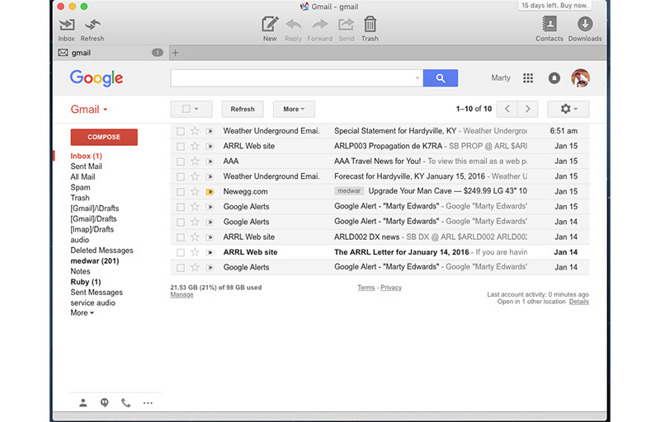
- Mailplane dock icon how to#
- Mailplane dock icon mac os x#
- Mailplane dock icon archive#
- Mailplane dock icon full#
Mailplane dock icon mac os x#
Mailplane has a few minor issues here and there, most of them apparently due to the fact that the program is stuffing a Web application into a Mac OS X program. You can assign labels to messages and conversations using a similar procedure. (You can’t log in to two accounts at the same time, however.) I also like Mailplane’s keyboard navigation: press Shift+G and a Navigate box pops up type enough of the name of a Gmail view or label to uniquely identify it, and then press return to jump to that view.
One of my favorite features is that you can set up multiple Gmail accounts in Mailplane select one in the Accounts drawer and click on Switch To, and Mailplane logs you out of the current account and into the new one. And the program supports both Address Book for adding recipients and OS X’s media browser for adding photos and other media to messages. Mailplane can notify you of new messages via its Dock icon, a menu-bar item, and audible alerts. A plug-in for iPhoto lets you send photos from within iPhoto using Mailplane. You can set Mailplane-and, thus, Gmail-as your default client, so clicking an e-mail link in any program opens a new Gmail message in Mailplane.
Mailplane dock icon archive#
There's a February 2011 copy in the Internet Archive Wayback Machine.As a standalone e-mail client, Mailplane also supports standard OS X features. … Before Salsita, Matthew led the development of a Mozilla Labs project called Prism (later WebRunner), a "single-site browser" that enabled users to turn web apps into desktop apps … Prism – MozillaWiki refers to Chromeless and WebRunner. Get free Dock icons in iOS, Material, Windows and other design styles for web, mobile, and graphic design projects. … The ideas and code for Chromeless have grown into the HTML5 Applications project. To a 2012 question, Chromeless “inactive”?, Michael replied: – and whilst Webian Shell may be of interest to readers, it's not an answer to the question.
Mailplane dock icon full#
Webian Shell: A full screen web browser built on Chromeless Two successors to Prism Mozilla Labs ChromelessĬhromeless | Mozilla Labs comprises two 2011 blog posts:

Gmail accounts with two letter domains are now supported. 'File > Save Clip' runs now in the background which avoids blocking Mailplane. Opens the Simplify Gmail Extension settings page via the 'Mail > Extensions > Simplify Gmail' menu item.
Mailplane dock icon how to#
I put up a blog post on how to use Mozilla Prism, in which I go into more detail about the various features. Fixes and Improvements Re-open last visited Gmail location on Mailplane startup. Yes, it is an "inactive" project, but it still works well. This is my personal favorite and I've been using it for a while. However, Boxysuite has an edge with notification badges on its dock and Launchpad app icons, making it possible to check the number of new emails at a. But it's quite limited compared to solutions like Fluid or Mailplane - as the name suggests, it's more of a popup than a standalone app. That will give you a standalone app you can run to get a browser for a specific site. Add a Get Specified URLs action, and enter the URL of the page you want.In Automator, create a new Application.There's a good article from Andy Ihnatko on the subject, but the short version is: If you don't want a third party app, you can make a very basic site-specific browser using Automator. you use simultaneously, Mailplane is the app you need to have on your Mac. Since it's specific to Gmail, it's a bit more finely tuned, with toolbar buttons for the usual sorts of mail app actions. Set up IMAP in Gmail: In Gmail, click on the icon in the top right-hand. It's free, but for $4.99 you get some extra features. Pretty useful for web apps like Gmail, but you can use for on pretty much any site. Fluidįluid lets you turn sites into single apps that appear like any other OS X app - in their own windows, with separate dock icons. There's no built-in OS X behaviour that exactly matches that of iOS, but you can use what's often referred to as a site-specific browser to turn sites into OS X apps.


 0 kommentar(er)
0 kommentar(er)
